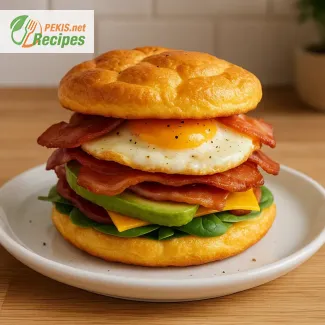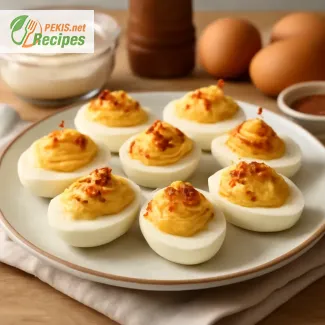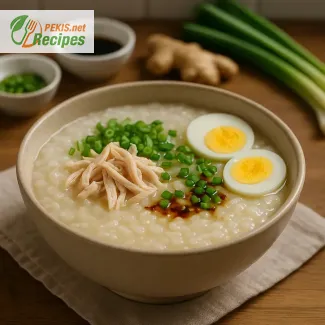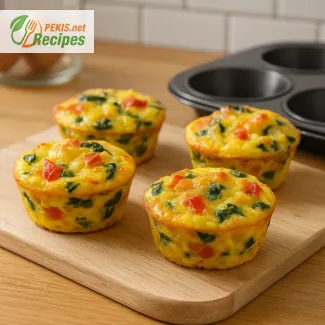
A New Way to Start Your Day: Fluffy, Light, and Satisfying
Discover the protein-packed breakfast sandwich that’s taking low-carb eating to the next level
If your mornings need a low-carb boost without sacrificing flavor, the Cloud Bread Breakfast Sandwich might just be your new go-to. This light and airy alternative to traditional bread transforms the typical breakfast sandwich into a gluten-free, keto-friendly option that feels indulgent but fits perfectly into a mindful eating routine. Whether you're following a keto diet, managing your carbs, or simply exploring healthier breakfast ideas, this sandwich delivers both taste and texture with surprising simplicity.
The concept of cloud bread isn’t new, but it has found a revitalized following among breakfast lovers who are tired of dense alternatives or dry, rubbery substitutes. With just a few base ingredients and the right technique, cloud bread becomes the perfect canvas for your morning sandwich: fluffy enough to feel like bread, yet light enough to keep you energized and focused.
Why cloud bread is the perfect base for breakfast sandwiches
Unlike traditional slices of bread that often come loaded with carbohydrates, cloud bread is made primarily from eggs and cream cheese or yogurt, offering a soft, sponge-like texture that’s rich in protein. It contains no flour, no gluten, and no added sugars, which makes it ideal for those avoiding grains or looking to maintain ketosis. Its versatility and neutral flavor allow it to pair beautifully with both savory and sweet toppings.
When used in a breakfast sandwich, cloud bread becomes more than just a vehicle for fillings—it becomes part of the flavor experience. It absorbs just enough of the juices from your eggs, bacon, or avocado to make every bite moist and delicious, while holding its structure better than most low-carb wraps or lettuce substitutes.
Trending: Cloud bread sandwiches on the rise
More and more home cooks are discovering the convenience of cloud bread. Its rise in popularity isn’t just tied to diet trends; it’s about rethinking what a satisfying breakfast looks like. The cloud bread sandwich taps into the growing interest in foods that are simple to make, visually appealing, and nutritionally aligned with today’s lifestyle choices. TikTok and Instagram have played a huge role in its comeback, with reels showcasing golden-baked rounds stuffed with everything from classic bacon and egg to plant-based alternatives and smoked salmon.
For busy mornings, the cloud bread sandwich is especially handy. You can prep a batch of the “bread” in advance and refrigerate it for quick assembly during the week. The fillings are customizable, so it can be as minimal or as decadent as you want—perfect for individuals, couples, or even families looking for a breakfast upgrade.
Ideal for keto and low-carb lifestyles
If you're living a ketogenic lifestyle, finding a sandwich that doesn’t derail your macros can be a challenge. That’s where the cloud bread breakfast sandwich comes in. Its low-carb profile makes it a smart choice, while the high-protein content keeps you feeling full longer. Pair it with a fried egg, sliced avocado, or some turkey bacon, and you have a complete breakfast that fuels your morning without the post-meal crash.
Even those who aren't strictly keto can enjoy the benefits. Whether you're looking to reduce processed carbs, avoid gluten, or simply eat cleaner, cloud bread is a versatile solution that works across dietary needs. It's also great for those with sensitive digestion, as it's much easier on the stomach compared to conventional wheat-based bread.
Texture, taste, and satisfaction in every bite
Let’s talk texture. One of the biggest hurdles for alternative breads is mouthfeel—too often they’re dry, crumbly, or rubbery. Cloud bread, when prepared correctly, strikes a unique balance between soft and structured, offering a melt-in-your-mouth bite that holds together even when stacked with rich fillings.
Taste-wise, cloud bread is mildly savory with a subtle tang, especially when yogurt is used. This makes it ideal for layering with classic breakfast ingredients like cheese, sausage, or herbed cream spreads. Because it’s so neutral, it can also be used for sweet versions of breakfast sandwiches—think berries, nut butter, and a drizzle of honey.
A smart choice for families and meal preppers
For families, this sandwich can be a game-changer at the breakfast table. It’s a fun and easy way to introduce kids to low-carb eating without making it feel restrictive. You can get creative with fillings—mini omelets, sliced turkey, even peanut butter and banana—and offer variety while keeping meals nutritious and exciting.
Meal preppers will also appreciate the portability and storage benefits. Cloud bread rounds can be baked ahead of time and stored in the fridge or freezer, ready to be reheated and filled on demand. That means no last-minute grocery runs, no morning kitchen chaos, and no compromise on taste or nutrition.
Customize your morning routine with endless variations
One of the biggest strengths of the cloud bread breakfast sandwich is how adaptable it is. Whether you prefer vegetarian options, dairy-free spreads, or spicy sausage patties, cloud bread provides a base that works with your preferences. Add fresh herbs or spices into the bread itself for a flavor boost, or switch up your fillings weekly to keep breakfast interesting.
You can make it a high-protein power meal with egg whites and turkey, go Mediterranean with grilled vegetables and feta, or even make it sweet and savory by adding bacon and a sugar-free maple glaze. The possibilities are endless, which makes it a perfect fit for anyone trying to eat better without getting bored.
From trend to staple: Why it’s here to stay
The cloud bread breakfast sandwich may have started as a viral trend, but it’s clear that it’s evolved into something much more. Its combination of simplicity, nutritional value, and satisfying taste makes it a permanent addition to the kitchens of health-conscious eaters, busy professionals, and foodies alike.
This isn’t just another substitute. It’s a delicious alternative that feels like an upgrade, not a compromise. Whether you're exploring new options for your breakfast lineup or fully committed to a low-carb way of life, the cloud bread breakfast sandwich deserves a spot on your table.
Step 1 – Preheat and prepare baking tray
Preheat the oven to 150 °C (300 °F). Line a baking tray with parchment paper and lightly grease it with olive oil (10 ml / 2 tsp).
Step 2 – Whip egg whites
In a clean, dry bowl, whip the egg whites (from 4 separated eggs) with baking powder (1 tsp) until stiff peaks form. This creates the volume and structure for the cloud bread.
Step 3 – Mix yolk mixture
In another bowl, whisk the 4 egg yolks with cream cheese (100 g / 3.5 oz) and salt (1 g / ¼ tsp) until smooth and creamy.
Step 4 – Combine mixtures
Gently fold the yolk mixture into the egg whites using a spatula, taking care not to deflate the egg whites. Mix until no white streaks remain, but the batter stays airy.
Step 5 – Form cloud bread rounds
Spoon the batter onto the baking tray in 8 even round portions (each about 10–12 cm / 4–5 inches in diameter). Smooth them slightly and brush tops with beaten egg (1 piece) for a golden finish.
Step 6 – Bake
Bake for 25 minutes or until the tops are golden brown and firm to the touch. Let cool slightly on a rack.
Step 7 – Prepare fillings
While cloud bread is baking, cook turkey bacon (8 slices) until crispy. Prepare 4 fried or scrambled eggs, slice avocado, and prepare cheddar slices.
Step 8 – Assemble sandwiches
Layer one cloud bread round with spinach (15 g / 0.5 oz), one egg, two bacon slices, avocado slices, and cheddar (25 g / 0.9 oz). Season with black pepper (1 g / ¼ tsp). Top with another cloud bread round. Repeat for each sandwich.
Transform Your Breakfast Routine with Smart Ingredient Tweaks
Upgrade the cloud bread sandwich with chef-level techniques and nutrient-rich alternatives
Perfecting a Cloud Bread Breakfast Sandwich isn't just about following the recipe—it's about understanding how each ingredient contributes to the final experience and how small changes can lead to big improvements in texture, flavor, and nutritional value. While the basic preparation is straightforward, there’s room for creative expression and customization that can elevate your homemade version far above any store-bought option.
Understanding the core of cloud bread success
Cloud bread, unlike traditional wheat-based bread, relies heavily on aerated egg whites for its structure. Achieving a good rise and soft texture depends on your ability to create and maintain stable, stiff peaks during the whipping process. A common mistake is either under-whipping or over-whipping the whites. Under-whipped whites result in flat bread, while over-whipped whites create an unstable foam that collapses quickly. To strike the right balance, beat until peaks hold firmly but remain glossy, and fold in the yolk mixture gently using a spatula.
Another critical step is the folding technique. Stirring aggressively will deflate the whites, leading to dense rounds. A light, slow fold maintains the volume and gives your cloud bread its signature airy texture.
Ingredient enhancements that boost both taste and nutrition
While the standard recipe calls for cream cheese, you can enhance flavor and health benefits by substituting it with plain Greek yogurt. This adds a subtle tang and increases probiotic content while reducing saturated fat. For those wanting a dairy-free version, opt for unsweetened coconut yogurt or cashew-based cream cheese alternatives, which retain creaminess without compromising taste.
For extra flavor in the bread itself, consider incorporating herbs or spices into the yolk mixture before folding. A pinch of garlic powder, smoked paprika, or dried chives adds depth and makes the bread a savory component rather than just a neutral base. These seasonings complement eggs, cheese, and avocado without overwhelming the palate.
Making the filling your own: proteins, greens, and layers of flavor
The filling offers endless possibilities for customization. Instead of traditional bacon or sausage, try smoked salmon or grilled tofu slices. These alternatives deliver a cleaner protein profile and create a more refined flavor. Swapping in baby arugula or microgreens for spinach introduces a peppery bite and boosts vitamin K and antioxidants.
For cheese, aged options like gruyère or goat cheese bring complexity and melt beautifully. These upgrades transform a simple sandwich into a gourmet breakfast experience, perfect for a weekend brunch or a special weekday treat.
Common pitfalls and how to avoid them
One frequent issue when preparing this sandwich is the bread sticking to the parchment paper after baking. To prevent this, ensure the paper is lightly greased with oil and the oven is properly preheated. Removing the bread too soon also risks tearing, so allow a cooling period of at least 5 minutes before transferring.
Another misstep is assembling the sandwich while the components are still steaming hot, which causes the structure of the cloud bread to soften and collapse. Allow the bread and fillings to reach a warm—not hot—temperature before stacking.
Why homemade beats store-bought every time
Making this sandwich at home gives you complete control over quality and freshness. You can use organic, free-range eggs, ensure no preservatives or additives, and make smart swaps to fit dietary needs. Beyond that, homemade cloud bread tends to be lighter, fluffier, and more flavorful, especially when baked just before assembly.
It’s also more cost-effective. Many commercial low-carb breads are expensive and often contain long lists of unpronounceable ingredients. With just a few kitchen staples, you can make a version that tastes better and aligns with clean eating goals.
Health-forward swaps for more balance
To lower the sodium content, opt for low-sodium bacon or turkey alternatives and use unprocessed cheese. You can also add fiber by including a thin layer of mashed avocado mixed with ground flax or chia seeds. This adds texture and promotes digestive health, while keeping the rich, creamy mouthfeel intact.
If you’re managing cholesterol, replacing one or two egg yolks with whipped aquafaba (the liquid from canned chickpeas) in the bread base provides a surprisingly effective alternative, maintaining the signature cloud-like texture.
Enhancing texture and presentation
To further improve texture, add a touch of almond flour (5–10 g) to the yolk mixture for added body. This makes the bread slightly denser and better able to support hearty fillings. For aesthetics, top each round with a few poppy seeds or sesame seeds before baking. It adds a visual appeal and a slight crunch that contrasts with the soft interior.
Serving your sandwich on a warm ceramic plate with a side of fresh greens or sliced seasonal fruit also elevates the presentation and enhances the overall sensory experience.
What makes the cloud bread breakfast sandwich so appealing is its adaptability. It fits a variety of dietary approaches—from paleo and keto to vegetarian and gluten-free—and offers a blueprint you can modify to suit your mood, ingredients on hand, or nutritional goals.
By tweaking just a few elements, you can turn a simple low-carb breakfast into a nutrient-dense, gourmet experience that’s easy to prepare, visually beautiful, and deeply satisfying.
Allergens present in the recipe
- Eggs
- Milk (cheese, cream cheese)
Contains gluten: No
Tips to eliminate allergens and gluten:
- Replace cheddar and cream cheese with dairy-free vegan cheese alternatives.
- Replace eggs with vegan egg substitutes (e.g. aquafaba for cloud bread, tofu scramble for filling).
Vitamins and minerals per serving (approximate)
- Vitamin A: 450 µg – supports vision and immune health
- Vitamin D: 2.1 µg – contributes to calcium absorption and bone health
- Vitamin B12: 1.5 µg – essential for nerve function and red blood cell production
- Folate (B9): 80 µg – crucial for DNA synthesis and cell repair
- Potassium: 420 mg – helps regulate fluid balance and muscle contractions
- Calcium: 180 mg – important for bones and teeth
- Iron: 2.2 mg – supports oxygen transport in the blood
- Magnesium: 40 mg – aids muscle function and energy production
Antioxidants per serving (approximate)
- Lutein: 150 µg – supports eye health and prevents macular degeneration
- Beta-carotene: 400 µg – precursor to vitamin A, protects cells from oxidative stress
- Vitamin E: 2.5 mg – protects cell membranes and supports skin health
- Glutathione: trace – helps detoxify and boost immune system function
- Zeaxanthin: 120 µg – works synergistically with lutein for vision protection





